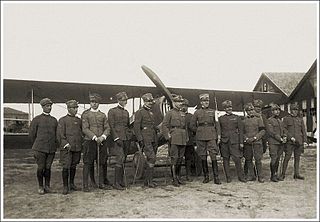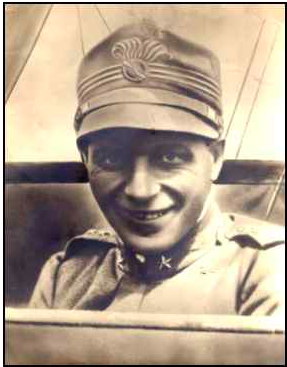
Count Francesco Baracca was Italy's top fighter ace of World War I. He was credited with 34 aerial victories. The emblem he wore side by side on his plane of a black horse prancing on its two rear hooves inspired Enzo Ferrari to use it on his racing car and later in his automotive company.

Lieutenant General Count Pier Ruggero Piccio was an Italian aviator and the founding Chief of Staff of the Italian Air Force. With 24 victories during his career, he is one of the principal Italian air aces of World War I, behind only Count Francesco Baracca and Tenente Silvio Scaroni. Piccio rose to the rank of Lieutenant General and in later years, became a Roman senator under the Fascists before and during World War II.

Bartolomeo "Meo" Costantini was an Italian aviator and racing car driver, known for being the sporting manager of the Bugatti car manufacturer.

Fulco VIII, Prince Ruffo di Calabria, 6th Duke of Guardia Lombarda was an Italian World War I flying ace and senator of the Kingdom from 1934 until his death. He was the father of Paola, Queen of the Belgians.

The Italian Corpo Aeronautico Militare was formed as part of the Regio Esercito on 7 January 1915, incorporating the Aviators Flights Battalion (airplanes), the Specialists Battalion (airships) and the Ballonists Battalion. Prior to World War I, Italy had pioneered military aviation in the Italo-Turkish War during 1911–1912. Its army also contained one of the world's foremost theorists about the future of military aviation, Giulio Douhet; Douhet also had a practical side, as he was largely responsible for the development of Italy's Caproni bombers starting in 1913. Italy also had the advantage of a delayed entry into World War I, not starting the fight until 24 May 1915, but took no advantage of it so far as aviation was concerned.
Tenente-colonnello Alessandro Resch was an Italian World War I flying ace credited with five confirmed aerial victories. After surviving World War I, he would become a pioneering airline captain, flying 500,000 miles between 1928 and 1935. He would return to the Italian Air Force as a major in 1935, rising to tenente-colonnello by 1939. His participation in World War II is unknown.
Tenente Giovanni Sabelli was an Italian World War I flying ace credited with five aerial victories. At the start of World War I, he was already an experienced combat pilot.

Sergente Cesare Magistrini began his lengthy aviation career as a World War I flying ace credited with six confirmed and four unconfirmed aerial victories.
MarescialloGuido Nardini (1881-1928) was a World War I flying ace credited with six aerial victories.

Tenente Giorgio Pessi was a World War I flying ace born in Austria-Hungary who chose to fly for Italy. He was credited with six aerial victories.
TenenteLuigi Olivari was a World War I flying ace who claimed 19 aerial victories. His Spad VII stalled into a fatal crash on 13 October 1917. Posthumously, he was awarded credit for eight aerial victories.
Tenente Gastone Novelli was a World War I flying ace credited with eight aerial victories.

Brigadier General Ferruccio Ranza began his military career as a World War I flying ace credited with seventeen confirmed victories and eight unconfirmed ones. Postwar, he rose to command of several area commands of the resurgent Italian Air Force. He served through the end of World War II.

71a Squadriglia of the Corpo Aeronautico Militare was one of the original fighter squadrons of the Italian military. Founded on 30 January 1916 to fight in World War I, the squadron served until war's end. It flew almost 3,000 combat sorties in defense of Italy at a cost of six pilots killed, scored 17 victories, and produced two aces from its ranks.

76a Squadriglia of the Corpo Aeronautico Militare was one of Italy's original fighter squadrons, being founded during World War I on 25 May 1916. On 30 May 1916, the new unit began its combat career. Between 22 April and 3 October 1917, three of its commanding officers became casualties. It was drawn into the air fighting over Caporetto in late 1917, and forced to retreat three times during November as a consequence of the Italian defeat.
77a Squadriglia was one of the first Italian fighter squadrons. After its founding on 31 May 1916, it began flying combat in July 1916, and would operate until the end of World War I. It was one of the squadrons drawn into late 1917's Battle of Caporetto, and forced to retreat after the Italian defeat. By the time the Austro-Hungarians sued for peace, 77a Squadriglia could count some 50 aerial victories scored in about 250 victories.
79a Squadriglia was one of Italy's first fighter squadrons. It served in combat during World War I from 13 January 1917 though war's end. It was credited with 47 aerial victories.

81a Squadriglia was an Italian fighter squadron raised in March 1917 that served through the end of World War I. One of its aces, Flavio Baracchini, would become the first awardee of the Gold Medal for Military Valor. The squadron would be credited with 34 aerial victories, and suffer four dead. It ended the war with 28 aircraft on strength.
260a Squadriglia was Italy's first naval fighter squadron. It served during the last year of World War I, from November 1917 to November 3, 1918. It operated Macchi seaplane fighters over the northern Adriatic Sea. During Italy's final offensive, it flew overland missions to support Italy's army in its victory over the Austro-Hungarian Empire. The squadron had three pilots become flying aces while serving with it.

Mario Ugo Gordesco was an Italian captain and aviator of the Regia Aeronautica during World War I. He is considered to be a pioneer within Italian aviation and was a major figure within the early Regia Aeronautica.













